解读并列连词和状语从句
- 格式:pptx
- 大小:402.25 KB
- 文档页数:58
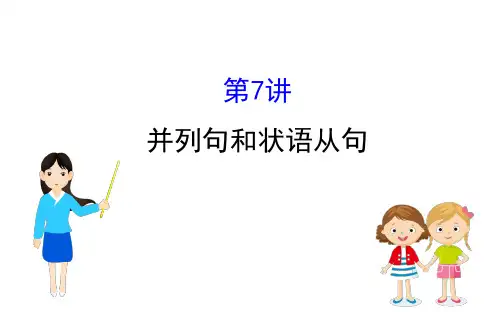
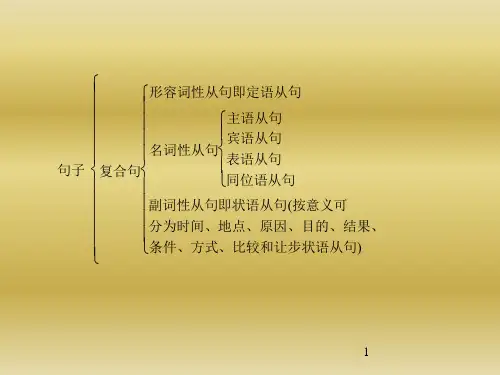

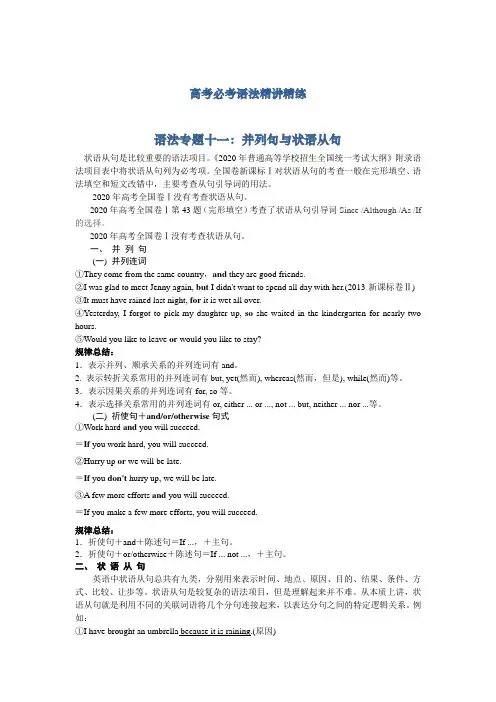
高考必考语法精讲精练语法专题十一:并列句与状语从句状语从句是比较重要的语法项目。
《2020年普通高等学校招生全国统一考试大纲》附录语法项目表中将状语从句列为必考项。
全国卷新课标Ⅰ对状语从句的考查一般在完形填空、语法填空和短文改错中,主要考查从句引导词的用法。
2020年高考全国卷Ⅰ没有考查状语从句。
2020年高考全国卷Ⅰ第43题(完形填空)考查了状语从句引导词Since /Although /As /If 的选择。
2020年高考全国卷Ⅰ没有考查状语从句。
一、并列句(一) 并列连词①They come from the same country,and they are good friends.②I was glad to meet Jenny again, but I didn't want to spend all day with her.(2013·新课标卷Ⅱ)③It must have rained last night, for it is wet all over.④Yesterday, I forgot to pick my daughter up, so she waited in the kindergarten for nearly two hours.⑤Would you like to leave or would you like to stay?规律总结:1.表示并列、顺承关系的并列连词有and。
2. 表示转折关系常用的并列连词有but, yet(然而), whereas(然而,但是), while(然而)等。
3.表示因果关系的并列连词有for, so等。
4.表示选择关系常用的并列连词有or, either ... or ..., not ... but, neither ... nor ...等。
(二) 祈使句+and/or/otherwise句式①Work hard and you will succeed.=If you work hard, you will succeed.②Hurry up or we will be late.=If you don't hurry up, we will be late.③A few more efforts and you will succeed.=If you make a few more efforts, you will succeed.规律总结:1.祈使句+and+陈述句=If ...,+主句。
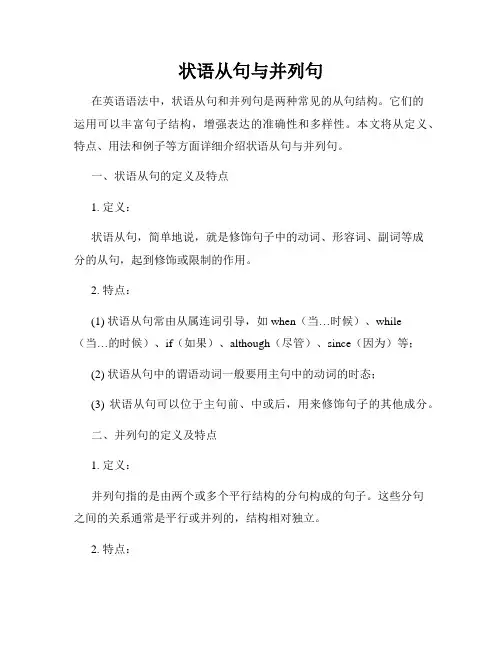
状语从句与并列句在英语语法中,状语从句和并列句是两种常见的从句结构。
它们的运用可以丰富句子结构,增强表达的准确性和多样性。
本文将从定义、特点、用法和例子等方面详细介绍状语从句与并列句。
一、状语从句的定义及特点1. 定义:状语从句,简单地说,就是修饰句子中的动词、形容词、副词等成分的从句,起到修饰或限制的作用。
2. 特点:(1) 状语从句常由从属连词引导,如when(当…时候)、while (当…的时候)、if(如果)、although(尽管)、since(因为)等;(2) 状语从句中的谓语动词一般要用主句中的动词的时态;(3) 状语从句可以位于主句前、中或后,用来修饰句子的其他成分。
二、并列句的定义及特点1. 定义:并列句指的是由两个或多个平行结构的分句构成的句子。
这些分句之间的关系通常是平行或并列的,结构相对独立。
2. 特点:(1) 并列句中的分句之间一般用逗号或并列连词连接,如and(和)、but(但是)、or(或者)等;(2) 并列句中的分句通常要保持结构平行,包括时态、语态、语气等方面的平行。
三、状语从句的用法及例子1. 时间状语从句:时间状语从句用来表示动作发生的时间,常由when、while、before、after、since等引导。
例子:- I will call you when I arrive at the airport.(当我到达机场时,我会给你打电话。
)- She was watching TV while her mother was cooking.(她妈妈在做饭的时候,她在看电视。
)2. 条件状语从句:条件状语从句用来表示主句动作发生的条件,常由if、unless、on condition that等引导。
例子:- If it rains tomorrow, we will stay at home.(如果明天下雨,我们会待在家里。
)- You can go outside unless it is too cold.(除非天气太冷,你可以出去玩。
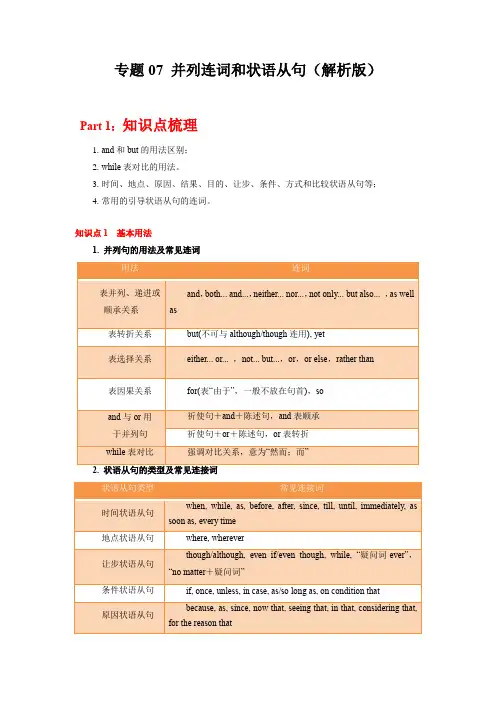
专题07 并列连词和状语从句(解析版)Part 1:知识点梳理1.and和but的用法区别;2.while表对比的用法。
3.时间、地点、原因、结果、目的、让步、条件、方式和比较状语从句等;4.常用的引导状语从句的连词。
知识点1基本用法1. 并列句的用法及常见连词用法连词表并列、递进或顺承关系and,both... and...,neither... nor...,not only... but also... ,as well as表转折关系but(不可与although/though连用), yet表选择关系either... or... ,not... but...,or,or else,rather than 表因果关系for(表“由于”,一般不放在句首),soand与or用于并列句祈使句+and+陈述句,and表顺承祈使句+or +陈述句,or 表转折while表对比强调对比关系,意为“然而;而”2. 状语从句的类型及常见连接词状语从句类型常见连接词时间状语从句when, while, as, before, after, since, till, until, immediately, as soon as, every time地点状语从句where, wherever让步状语从句though/although, even if/even though, while, “疑问词-ever”,“no matter+疑问词”条件状语从句if, once, unless, in case, as/so long as, on condition that原因状语从句because, as, since, now that, seeing that, in that, considering that, for the reason that结果状语从句so that, so/such... that目的状语从句so that, in order that, for fear (that), in case比较状语从句than, as... as, not so... as方式状语从句as, as if/as though知识点2 时间状语从句关联词或短语意义例句when,while,as当……的时候He jumped up when the phone rang.We listened while the teacher read.The phone rang just as I was leaving.(as强调主、从句动作同时或几乎同时发生;while从句的谓语动词必须是延续性动词,不能是非延续性动词)till,until 直到Jane completed her last novel Persuasion in 1816,but it was not published until after her death.(until要与延续性动词连用;not...until 要与非延续性动词连用)since 自从It is two years since he joined the army.他参军两年了。
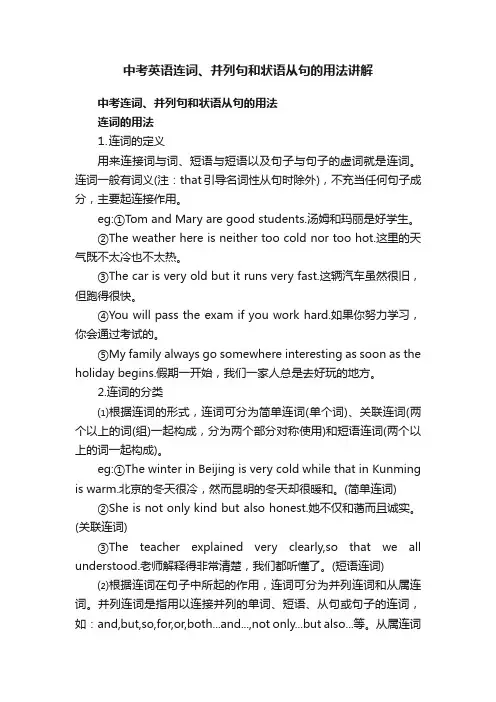
中考英语连词、并列句和状语从句的用法讲解中考连词、并列句和状语从句的用法连词的用法⒈连词的定义用来连接词与词、短语与短语以及句子与句子的虚词就是连词。
连词一般有词义(注:that引导名词性从句时除外),不充当任何句子成分,主要起连接作用。
eg:①Tom and Mary are good students.汤姆和玛丽是好学生。
②The weather here is neither too cold nor too hot.这里的天气既不太冷也不太热。
③The car is very old but it runs very fast.这辆汽车虽然很旧,但跑得很快。
④You will pass the exam if you work hard.如果你努力学习,你会通过考试的。
⑤My family always go somewhere interesting as soon as the holiday begins.假期一开始,我们一家人总是去好玩的地方。
2.连词的分类⑴根据连词的形式,连词可分为简单连词(单个词)、关联连词(两个以上的词(组)一起构成,分为两个部分对称使用)和短语连词(两个以上的词一起构成)。
eg:①The winter in Beijing is very cold while that in Kunming is warm.北京的冬天很冷,然而昆明的冬天却很暖和。
(简单连词)②She is not only kind but also honest.她不仅和蔼而且诚实。
(关联连词)③The teacher expl ained very clearly,so that we all understood.老师解释得非常清楚,我们都听懂了。
(短语连词)⑵根据连词在句子中所起的作用,连词可分为并列连词和从属连词。
并列连词是指用以连接并列的单词、短语、从句或句子的连词,如:and,but,so,for,or,both...and...,not only...but also...等。
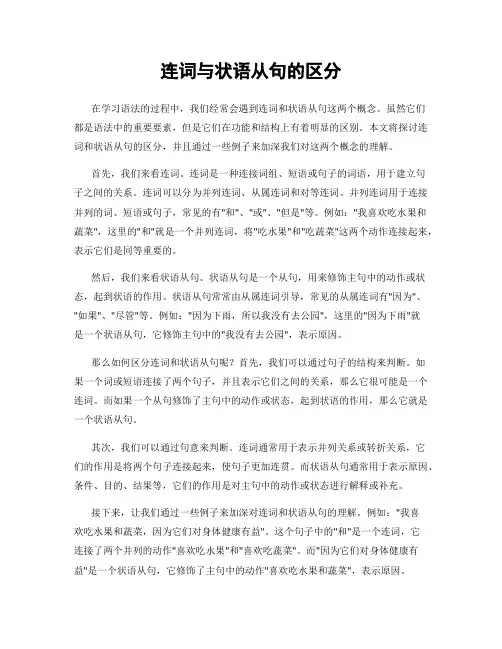
连词与状语从句的区分在学习语法的过程中,我们经常会遇到连词和状语从句这两个概念。
虽然它们都是语法中的重要要素,但是它们在功能和结构上有着明显的区别。
本文将探讨连词和状语从句的区分,并且通过一些例子来加深我们对这两个概念的理解。
首先,我们来看连词。
连词是一种连接词组、短语或句子的词语,用于建立句子之间的关系。
连词可以分为并列连词、从属连词和对等连词。
并列连词用于连接并列的词、短语或句子,常见的有"和"、"或"、"但是"等。
例如:"我喜欢吃水果和蔬菜",这里的"和"就是一个并列连词,将"吃水果"和"吃蔬菜"这两个动作连接起来,表示它们是同等重要的。
然后,我们来看状语从句。
状语从句是一个从句,用来修饰主句中的动作或状态,起到状语的作用。
状语从句常常由从属连词引导,常见的从属连词有"因为"、"如果"、"尽管"等。
例如:"因为下雨,所以我没有去公园",这里的"因为下雨"就是一个状语从句,它修饰主句中的"我没有去公园",表示原因。
那么如何区分连词和状语从句呢?首先,我们可以通过句子的结构来判断。
如果一个词或短语连接了两个句子,并且表示它们之间的关系,那么它很可能是一个连词。
而如果一个从句修饰了主句中的动作或状态,起到状语的作用,那么它就是一个状语从句。
其次,我们可以通过句意来判断。
连词通常用于表示并列关系或转折关系,它们的作用是将两个句子连接起来,使句子更加连贯。
而状语从句通常用于表示原因、条件、目的、结果等,它们的作用是对主句中的动作或状态进行解释或补充。
接下来,让我们通过一些例子来加深对连词和状语从句的理解。
例如:"我喜欢吃水果和蔬菜,因为它们对身体健康有益"。
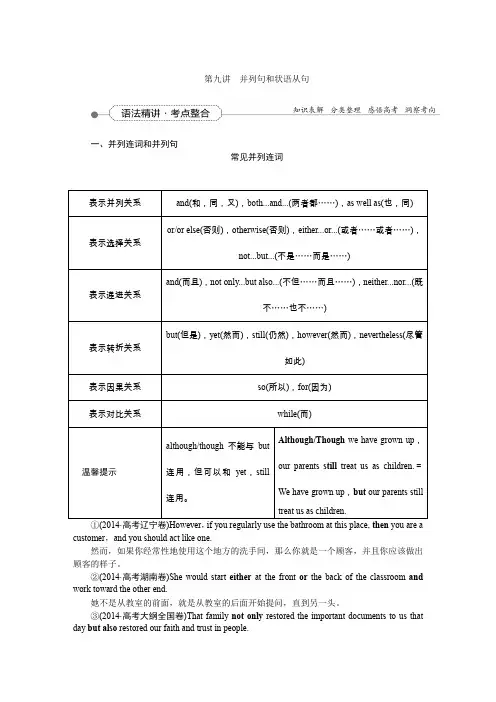
第九讲并列句和状语从句一、并列连词和并列句常见并列连词温馨提示customer,and you should act like one.然而,如果你经常性地使用这个地方的洗手间,那么你就是一个顾客,并且你应该做出顾客的样子。
②(2014·高考湖南卷)She would start either at the front or the back of the classroom and work toward the other end.她不是从教室的前面,就是从教室的后面开始提问,直到另一头。
③(2014·高考大纲全国卷)That family not only restored the important documents to us that day but also restored our faith and trust in people.那个家庭在那天不仅归还了我们那份重要的文档,还让我们重新拥有了对人的信心和信任。
④(2013·高考新课标全国卷Ⅱ)I was glad to meet Jenny again,but I didn’t want to spend all day with her.很高兴又见到Jenny了,但是我不想花一整天时间和她在一起。
⑤(2015·苏州高三模拟)Yesterday,I forgot to pick my son up,so he waited in the kindergarten for nearly two hours.昨天我忘记去接我的儿子了,因此他在幼儿园等了几乎两个小时。
⑥At school,some students are active while some are shy,yet they can be good friends with one another.在学校,有些学生是活跃的而有些学生是害羞的,但是他们可以成为彼此的好朋友。

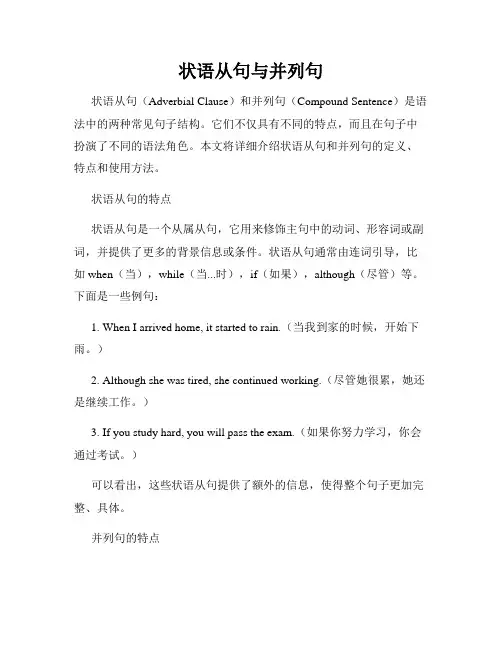
状语从句与并列句状语从句(Adverbial Clause)和并列句(Compound Sentence)是语法中的两种常见句子结构。
它们不仅具有不同的特点,而且在句子中扮演了不同的语法角色。
本文将详细介绍状语从句和并列句的定义、特点和使用方法。
状语从句的特点状语从句是一个从属从句,它用来修饰主句中的动词、形容词或副词,并提供了更多的背景信息或条件。
状语从句通常由连词引导,比如when(当),while(当...时),if(如果),although(尽管)等。
下面是一些例句:1. When I arrived home, it started to rain.(当我到家的时候,开始下雨。
)2. Although she was tired, she continued working.(尽管她很累,她还是继续工作。
)3. If you study hard, you will pass the exam.(如果你努力学习,你会通过考试。
)可以看出,这些状语从句提供了额外的信息,使得整个句子更加完整、具体。
并列句的特点并列句是由两个或多个独立的子句组成的句子,这些子句平等地并列在一起,通过逗号、分号或者连词来连接。
并列句的结构如下:[独立子句1],[连词] [独立子句2]。
常见的并列连词有and(和)、but(但是)、or(或者)等。
下面是一些例句:1. I like playing basketball, and my sister likes playing tennis.(我喜欢打篮球,我姐姐喜欢打网球。
)2. It was raining heavily; therefore, we decided to stay at home.(雨下得很大,所以我们决定呆在家里。
)3. You can either come with us, or you can stay here.(你可以跟我们一起去,也可以留在这里。
第 12 讲并列句和状语从句两个或两个以上的简单句用连在一起构成的句子叫做并列句,其基本结构是“+并列连词+简单句”。
并列连词有 :and, but, or, so 等。
状语从句是在句子中起副词作用的句子。
依照状语从句在句中不相同的作用可分为:时间、地址、原因、目的、结果、条件、方式、退步和比较状语从句。
并列连词和隶属连词是高考的重要考点之一,在语法填空中平时以无提示词的方式进行观察,在短文改错中主要观察并列连词和隶属连词的误用。
并列句和状语从句的考点以下:中心考点 01 观察并列连词并列连词是用来连接两个或多个并列的词、短语或句子的词,主要表示并列、选择、转折、因果等关系。
并列连词在句子中地址比较固定,必定位于所连接的并列单位之间;两个并列连词不能够并用。
1.表示并列关系的连词表示并列关系的连词有and, both...and...,not only...but also...,neither...nor... 等。
2.表示选择关系的连词表示选择关系的连词有or, either...or...等。
3.表示转折关系的连词表示转折关系的连词有but, yet, while等。
4.表示因果关系的连词有for , so。
We listened eagerly, for he brought news of our families.作并列连词的用法当于when 除了作隶属连词,引导时间状语从句外and at this/that time 。
常用于以下句式:① sb. was doing sth. when...② sb. was about to/going to do sth. when...③ sb. was on the point of doing sth. when...,还可作并列连词,其意义为“这时,那时” ,相④ sb. had just done sth. when...。
如 :We were having a meeting when someone broke in.我们正在开会,这时有人闯了进来。
并列句与状语从句讲解连词是一种虚词,不能在句子中单独作句子成分,在句子中只起连接词与词、短语与短语、句子与句子以及从句的作用;一、并列句与连词连接同一语法类型的词、短语或句子1. 并列连词的分类并列连词按其作用可分为表示转折对比、因果、选择和并列四大类;1 表示转折的并列连词1.but但是,可连接两个句子,用逗号隔开;也可以放在句首2.yet 然而,尽管如此,连接两个句子,用逗号隔开;也可以放在句首The car is old,yet it is in good condition.注:yet也常放在完成时句尾表示还没有,此时不是连词,注意区分;3.while 而,可是,表示转折或对比,不用加逗号Lily likes go to school by bus while linda likes go to school by bike.4.however 然而,但是,一般位于句首,单个使用后加逗号阅读完型中常见到表转折;它们连接两个意思不同,阅读中遇到要注意;2 表示因果的并列连词表示因果的并列连词有:1.for 因为①由并列连词for 引导的分句常置于句子后部,而且常用逗号与前面的分句隔开;②for 分句主要是对前一分句补充说明理由或推断原因;③for 分句不能用来回答why 问句;She can’t go to school , for she is ill in bed.2.so 所以可以连接两个句子,中间有时用逗号隔开;也可以放在一个句子的句首;例:The shop doesn't open until 11 a.m. , so we should go there later..3.therefore 因此,用法和however类似,但词义不一样3 表示选择的并列连词表示选择的并列连词有:or 或者,either…or 不是……就是……,或者……或者……注①or用在祈使句中,意为“否则”,Hurry up, or you’ll be late. 快点,否则你就会迟到了;②or用在否定句中表示并列关系;They never dance or sing. 他们从不跳舞,也不唱歌;③either…or…连接主语时,谓语动词就近原则;4 表示并列关系的连词连接主语时注意谓语表示联合关系的连词有:1.and 和,而且 and ①用在肯定句中连接并列的成分,表示“和,而且”;②用在祈使句中,意为“那么”Study hard, and you will succeed. 努力学习,你就会取得成功;2.both…and…既……又,两者都谓语动词用复数Both you and he are right.3.as well as 也注谓语动词应与as well as 前面的主语在人称、数上保持一致;I as well as he am a doctor. 我和他一样,也是医生;4.not only…but also不但……而且……它连接主语时,谓语动词就近原则;Not only I but also students are tired of take the examination.5.neither…nor…既不……也不……它们用来连接两个并列关系的词、短语或分句;它连接主语时,谓语动词就近原则.Neither you nor she has ever gone the USA. 你从来没去过那,她也没去过;注:1.祈使句中and 表示那么,or表示否则2.谓语就近原则there be,either…or…,neither…nor…,not only…but also二、状语从句与连词1 引导时间状语从句的连词:时间状语从句服从主将从现Before把我们说过的例句写下来让他们填, after, when/while/as, since自从,用于完成时+since+过去时 ,not…until, as soon as一;;就;; 等;①when和while用法区别:while:She came in 点性while I was doing延续性my homework.我正在写作业的时候她进来了;When: I was doing my homework when she came in.我正在写作业,这时他进来了;②not…until,前加点性动词;肯定句时用延续性动词③as soon as 的主将从现I’ll tell her as soon as I see her. 我一见到她就告诉她;2 引导条件状语从句的连词:条件状语从句服从主将从现①if, 如果其引导的条件状语从句表示的前提或条件可以实现或正在进行,从句用现在完成时或进行时;I will give you a good price if you are thinking of buying it.③as long as, You’ll pass the exam as long as you work harder.④unless等; You’ll fail in the exam unless you work harder.⑤祈使句+and/or+陈述句意义上相当于条件状语从句3 引导原因状语从句的连词:because, as, since, for等;注意:如果原因是人们已经知道的事实,用since引导,有既然的意思4 引导目的状语从句的连词:①so that:He put on his glasses so that he could see it clearly.②in order that :1.与so as to 用法相同2.注意它与in order to的区别5 引导结果状语从句的词:such…that, so…that,She is so lovely a girl that we all like her.She is such a lovely girl that we all like her.注:区别当名词前有many或much修饰时,用so而不用such so much time6 引导地点状语从句的连词:where, wherever等;eg:Sit wherever you like. 请随便坐;7 引导让步状语从句的连词:though一般位于句中, although一般位于句首, even if,whatever, wherever, whenever等;Although he was tired, he kept on working. 虽然他很累,但仍继续工作;8 引导比较状语从句的连词: than, as…as, more…than…, the+比较级,the+比较级等;He doesn’t play half as well as his sister. 他演奏的水平不及他姐姐的一半;Our city is smaller than that one. 我们的城市比那个城市小;。
考点一:并列连词一,句子的分类句子分:简单句,并列句,复合句。
其中简单句的结构包括:主语+谓语;主语+谓语+宾语;主语+谓语+宾语+宾语补足语;主语+谓语+间接宾语+直接宾语;主语+系动词+表语。
并列句分为:表递进,表选择,表转折,表因果,其他复合句分为:定语从句,名词性从句(主语从句,宾语从句,表语从句,同位语从句),状语从句。
二,并列句的基本概念:并列句是由两个或两个以上并列二有独立的简单句构成的。
在并列句中,这些简单句常有并列连词连在一起。
并列连词所连接的简单句称为分句。
三,常见的并列连词1,表示递进或顺承关系:常用的并列连词有and,not only...but(also)…如:Not only did he speak more correctly, but also he spoke more easily.2,表示选择关系:常用的并列连词有or, either…or….等,如:Either you are right, or I am.3,表示转折关系:常用的并列连词有but ,yet , whereas等。
如:Jane said she was ill, yet I saw her in the street just now.4,表示因果关系:常用的并列连词有so , for等。
The shops were closed ,so I didn’t get any milk.5,When还可用作并列连词,意为那时,这时。
相当于and at this/ that time。
常用于下列句式:sb was doing sth when…; sb was about to do /going to do/on the point of doing sth when…; sb had just done sth when….如:We werehaving a meeting when someone broke in . we were about toset off when it suddenly began to rain.6,While 作为并列连词,意为而,却。